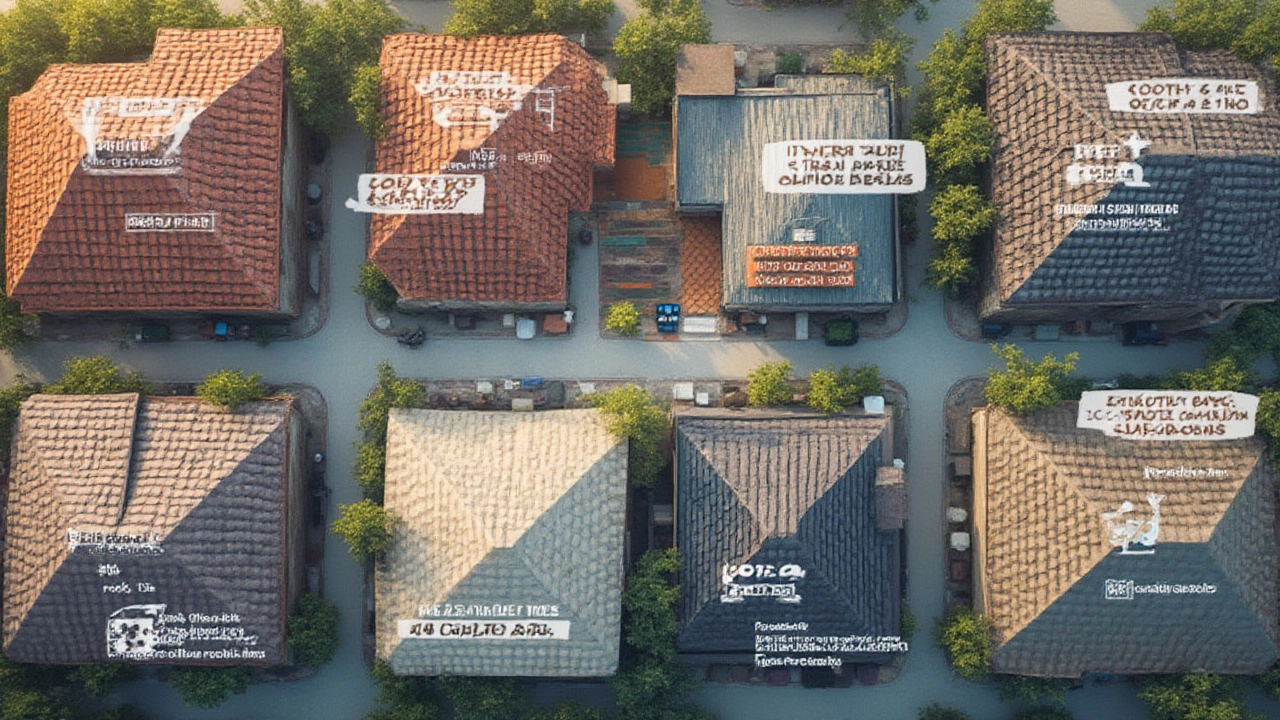Roof Replacement Budgeting Guide: Smart Steps for Homeowners

Sticker shock. That’s the first thing most folks feel when they find out what a new roof actually costs. Your last roof might have lasted decades, so the price tag today—anywhere from $6,000 to well over $20,000 for a standard-sized home—can feel like a punch to the gut. But there are ways to plan ahead, make smart choices, and avoid falling into money pits or making rookie mistakes that cost you even more.
What Goes Into the Cost of a Roof?
Most people only think about shingles, but there are a ton of things packed into that final quote. The pitch and size of your roof, the stuff underneath (think rotten wood, tangled old underlayment), the style of your house—all these add dollars. Labor is another huge chunk. It’s physically brutal, risky work, and experienced contractors aren’t cheap. According to Remodeling Magazine’s 2024 Cost vs. Value Report, the average cost for a roof replacement in the U.S. sits around $11,500, with luxury materials or steep roofs bumping it far higher.
Let’s break that down. Suppose you’ve got a 2,000-square-foot roof. Here’s what could go into the bill:
| Item | Avg. Cost (2024) |
|---|---|
| Asphalt Shingles | $5,000 - $8,000 |
| Metal Roofing | $14,000 - $18,000 |
| Labor (varies by region) | $3,500 - $8,000 |
| Underlayment & Flashing | $1,000 - $2,500 |
| Plywood Replacement | $2 - $5 per sq. ft. |
| Permits / Disposal | $500 - $1,000 |
Home insurance usually won’t cover routine wear and tear, but some policies will step in after storms or disasters. Always check this before you get started. And if you live in a city with tough building codes (hello, hurricane zones), expect to pay extra for special materials, engineering signoffs, and city fees.
Figuring Out Your Roofing Needs
Don’t just take a roofer’s word for what you need—do a little scouting yourself. Start by measuring your roof, not just the floorspace below. Roofs with towers, dormers, valleys, and steep pitches have more surface area than you think. Climbing up isn’t for everyone, so you can use Google Earth or drone shots for a rough idea.
Next, check what’s lurking under your shingles. Sagging spots might mean your decking (the planks holding your roof up) is rotting—replacing that will cost extra. Mold, leaks, and piles of granules in your gutters also point to bigger problems. Take note of every potential trouble spot.
You should also ask yourself: Is it time to upgrade the materials? If your area gets pummeled by hail, you might want to look at Class 4 impact-resistant shingles. Live somewhere scorching? Lighter colors and energy-efficient coatings can slice A/C bills.
Lastly, get a sense of your timeline. If you’re patching leaks every rainy season or noticing higher energy bills, don’t wait. Water damage and mold grow shockingly fast, and letting things slide will always cost more in the end.

How to Plan a Realistic Roof Budget
Start with the basics: Set aside 10-20% more than whatever the initial estimate is. Roofing projects almost always hit snags—hidden plywood rot, crumbling chimneys, or even surprise code upgrades. Contractors aren’t trying to nickel-and-dime you (well, the honest ones aren’t), but if you haven’t budgeted for hiccups, you can end up way over your head.
Split your budget into categories:
- Materials (shingles, underlayment, nails, flashing, etc.)
- Labor (the biggest cost if you’re not DIYing)
- Plywood/decking replacement
- Disposal (old shingles, rotten wood)
- Permits and inspections
- Emergency/contingency fund
Some pros will quote you an all-in price; others might break down each piece (make sure they’re comparing apples to apples). Get at least three detailed quotes. Don’t just look at the bottom line—dig into the fine print. Are dump fees included? What’s extra? Is there a warranty, and does it include labor or just materials?
And here’s a hot tip—check for local or federal programs that might pay for part of the job. In some cities, upgrading to energy-efficient roofing can score you rebates or even cover the cost if you meet certain income thresholds. Don’t leave free money on the table.
Picking Materials That Make Sense
Not all roofs are created equal. The material you pick sets your costs—not just at install, but for the next 20, 30, or 50 years. Asphalt shingles are still king in the U.S., mostly because they’re cheap and work almost everywhere. They’ll run you around $4 to $7 per square foot installed.
Metal roofs used to be for barns, but now they’re everywhere. They start expensive (usually $9 to $14 per square foot) but can outlast asphalt two or three times. Tile and slate are gorgeous and rock-solid, but those prices will make you sweat—$20 to $40 per square foot isn’t unusual. And because those materials are heavy, sometimes you have to reinforce your whole roof frame, piling on even more costs.
| Material | Avg. Lifespan | Price per Sq. Ft. |
|---|---|---|
| Asphalt Shingles | 15-30 years | $4-7 |
| Metal Roofing | 40-70 years | $9-14 |
| Tile | 50+ years | $15-25 |
| Slate | 75+ years | $20-40 |
Don’t forget about color and style. Lighter colors reflect heat, dark colors soak it in. In some places, insurance companies actually give you discounts for certain hail-resistant shingles or fire-resistant tile roofs. And if you’re planning to sell soon, keep an eye on resale value—nobody wants to buy a headache.

Ways to Save Without Getting Burned
Let’s be honest, roofing isn’t cheap. But you can be smart about it. Schedule work in the slower seasons (late winter or early spring) when roofers aren’t slammed—sometimes you’ll get discounts or shorter wait times. If you’re handy, you might do the tear-off yourself or handle small repairs, but don’t mess with full installs unless you know what you’re doing. Falls are the top reason for traumatic home-repair injuries, according to CDC data.
Do a little detective work on contractors. Ask for references (and actually call them). Check for licenses, insurance, and a permanent local address. The cheapest bid can cost you tons in do-overs and headaches if the work isn’t right. A strong warranty, both from the manufacturer and the contractor, is worth its weight in gold.
If your finances are tight, shops like credit unions offer solid rates on home improvement loans. In 2025, average HELOC rates hover around 8%, but special promotions sometimes dip lower. Just don’t max out your credit card—those interest rates can bury you.
If your area gets a lot of storms or hail, look into insurance riders or special policies now, before you replace your roof. A storm tomorrow won’t help you if your new shingles aren't covered.
Remember, a bad roof won’t wait. Water has a way of finding every crack, and every cheap shortcut you take now is a disaster just waiting to happen. Do it right, set aside a buffer, and don’t be afraid to ask for advice or a second opinion. Your future self will thank you next time the sky opens up with rain.
Here’s the basic truth: budgeting for a roof is all about preparation—doing your homework, having a backup fund, and thinking ahead. This is the kind of home expense that pays off for decades… if you tackle it smart.
Write a comment